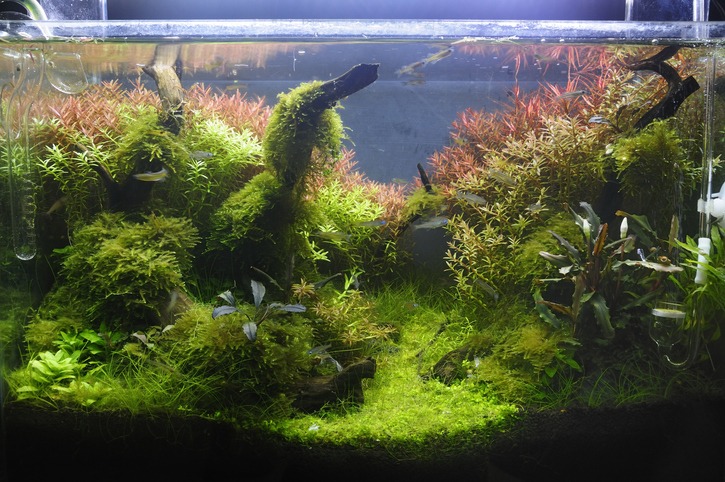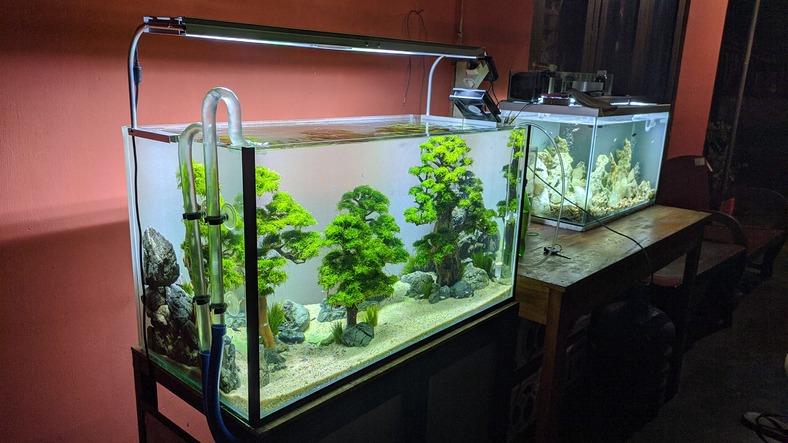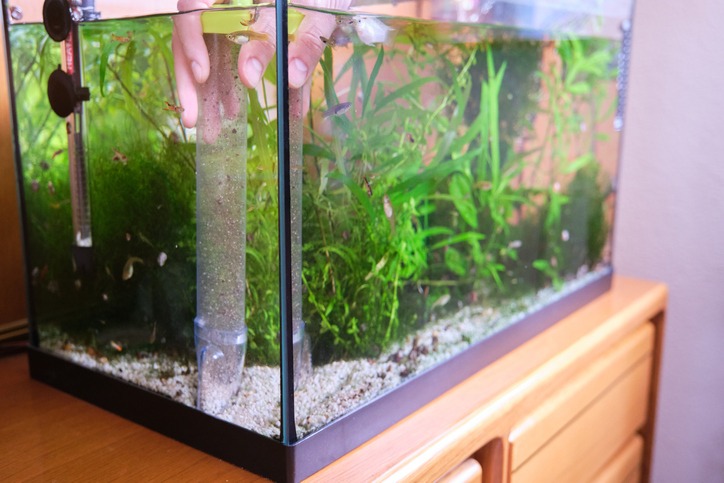Aquascaping is a growing trend we can see on various online platforms. Truly, the art of creating underwater landscapes and gardening particularly applied most in aquariums really looks fun and challenging at the same time. Aquascaping allows you to run your imagination and skills in layout and landscaping to create various sceneries and aesthetics that will add an extra layer of dazzle in your aquariums. Aquariums can be truly amazing and enjoyable.
Not only does it require a person to be extra creative, it also needs to be intricate and thorough. You have to be very knowledgeable about the proper aquarium environment since you will be using aquatic plants for the aquascaping setups. You need to know how various aquatic plants differ to each other when it comes to their needs. You can also use other decorating elements such as stones, driftwood, sand, or anything that will make your aquascape thriving and pleasing.
But what’s the most exciting about aquascaping is that it is a hobby that could fit everyone, especially those who have a soft spot in nature and landscaping. You can even say that it is a hobby just like gardening, but with an extra twist. So if you are looking for a simple and useful guide to Aquascaping, here are a few important tips and reminders for starters!
Visualize your Aquascape
While imagination and creativity could do magic when it comes to visualizing and conceptualization of your aquascape, always keep in mind that what is pleasing in the eyes does not equate to what is the best. Remember, the idea of aquascaping was to make underwater landscapes that could actually be suitable and perfect for the aquatic plants and fishes to thrive and grow. For aesthetics, determining the focal point—the point where viewers look first before scanning the entirety of the scape—could help you for proper placement of your aquatic plants, rocks, and other materials of your preference.
List down the necessary hardware and materials
- Lighting – Lighting is very important in aquascaping since most of the aquatic plants require more light than regular plants. Proper lighting would help the aquatic plants to grow and maintain their health for a long time.
- Carbon Dioxide – Carbon Dioxide systems are very much needed if you wanted to have a beautiful and healthy aquascape. No plant survives without carbon dioxide, and that is also the case for your aquatic plants. If you want them to live long and health, you have to invest to a good CO2 system.
- Water filters – Water filter would be very beneficial in maintaining your aquarium clean. It filters different wastes inside your aquarium which can harm your plants and fishes.
- Liquid Fertilizers – Liquid fertilizers are packed with vitamins and minerals for your aquatic plants which will keep them healthy and happy.
- Substrate – Aquascaping substrate is vital especially the aquatic plants since they also feed through their roots. There are various kinds of substrate in the market, so make sure you get the proper one for your aquatic plants.
- Hardscape materials – These materials refer to woods and rocks that could make your aquascape more unique and realistic. While plants can be very pleasing in the eyes, having a sharp and strong structure can work wonders especially if you are planning to put your beloved fishes inside the aquascape.
Aquascaping reminders
Before you proceed with creating your very own aquascape, you have to consider and keep a few things in mind.
- Rocks can be a game changer if used irresponsibly. In setting up big rocks in your aquascape, you have to create a thin layer of substrate that would keep the rock separate from the aquarium glass underneath. Rocks are hard materials which can possibly crack or break your aquarium when force is applied to it. Also, most rocks contain minerals that could throw of the chemical balance of the water which can endanger your plants and fishes. Be mindful of adding and placing rocks inside your aquascape, as most people say, the simpler the better.
- Avoid putting your decors in the center of your aquarium. The rule of thirds can be used when you are conflicted about your chosen setup. With this, the plants and fishes can grow and thrive beautifully. Most of the aquascapes today have a minimalist approach in style since it could bring out a more genuine and realistic touch to the aquascapes.
- Proper placement of plants are important. Use different variety of plants to make our aquascape more diverse. Acquire plants with different colors, sizes, and heights to make more depth and symmetry in your aquascape. This will give more compelling look in your creation.
- Choosing the right kind of fish can be the most crucial part of your aquascaping. Most people go with Tetra fishes for their aquascapes due to their small figure. They also have a habit of schooling which can be very relaxing and interesting to watch. Just make sure not to put too much fishes in your aquascape and be mindful about the temperature of your aquascape before putting your fishes. Stabilize the temperature of the fish’s container until it matches the temperature of the aquarium first so as to not kill or harm them.
Adding Equipment
Filter
Adding a filtration system to your tank is essential to make sure the nutrients are evenly distributed inside the tank. The filter’s circulation rate is something that you need to consider while purchasing and installing one.
As a general rule of thumb, you should opt for a filter that circulates water in your tank atleast 3 to 4 times an hour. For example, if your tank is 100-litres, the filter should circulate 300-litres in an hour. Plus, you should always opt for a filter with a slightly higher circulation rate.
The reason is that the conditions inside the tank are not always consistent. With time, as your tank gets older, slime and dirt will build up, which can decrease the flow rate.
Heater
In most cases, the temperature inside the heater is maintained at 78 degrees Fahrenheit, which is considered to be an appropriate temperature for most aquatic plants. If the temperature in your home does not support the optimum temperature recommended for the tank, you can add a heater to your aquarium.
At the same time, you can check and adjust the tank’s temperature by using the aquatic thermostat.
Planting the Aquarium
View this post on Instagram
When it comes to planting your aquarium, you need to keep in mind a few things. For instance, to prevent the plants from breaking loose, you should use tweezers to plant them an inch inside the soil. Plus, the short plants need to go in the front whereas the tall ones will go in the back.
Furthermore, fine-leaved plants with similar leaf patterns should go in front, and plants with petite roots should be planted in rocks, cracks, and shallow substrates.
However, the roots of plants like Anubias, moss, and fern should not be covered in the substrate. The reason is that their true roots have rhizomes in place. While moss can be tied to rock or wood, rhizomes can also be held objects or hardscapes.
Adding Water
When it is finally time to add water, make sure that your pour it slowly so that the substrate is not disturbed. Experts usually place a small bowl directly over the substrate and carefully pour the water. This way, the weight of the water does not allow the substrate to be disturbed.
Cycling the Aquarium
On average, it takes around six weeks for an aquarium to complete the nitrogen cycle. This allows the beneficial bacteria to grow in the tank and convert nitrites and ammonia. Otherwise, both ammonia and nitrates can have severe effects on the fish in the tank.
Adding Fish
View this post on Instagram
Do not add fish to your aquarium until the cycling process is complete. This will take about a week. Additionally, it will take a week for the beneficial bacteria to grow inside the substrate and filter media. With that said, do not add too many fishes at the same time.
The best practice is to add 1 inch of fish to every gallon of water in the aquarium.
FAQs: A simple guide to the art of Aquascaping
Here are some common questions asked about aquascaping.
1. What is needed for Aquascaping?
Aquscaping is usually done according to the needs and preferences of the customer. But the most common materials include paint, wood, cork and adhesive foliage. In addition to that, a filter system is also needed to ensure the fish remain healthy.
2. Is Aquascaping a career?
Yes, aquascaping is an art that requires a certain set of skills and experience. Many people around the world have turned it into their full-time career and build customized aquariums for their high-end clients. Furthermore, they are also hired by companies and corporations to build expensive and unique aquariums.
3. Are Aquascapes hard to maintain?
Aquacapes are not that hard to maintain if the owner regularly performs maintenance. A good quality liquid fertilizer and substrate system ensures that plants remain healthy and the overall water condition is optimum for the fish to thrive. A few minutes of cleaning and inspection can go a long way in reducing expensive replacement and repair costs.
Conclusion
Aquascaping can be very time-consuming and costly, but it can be a good hobby for those who love and appreciate the beauty of nature and art. We hope that you find this article helpful for your journey in aquascaping.



